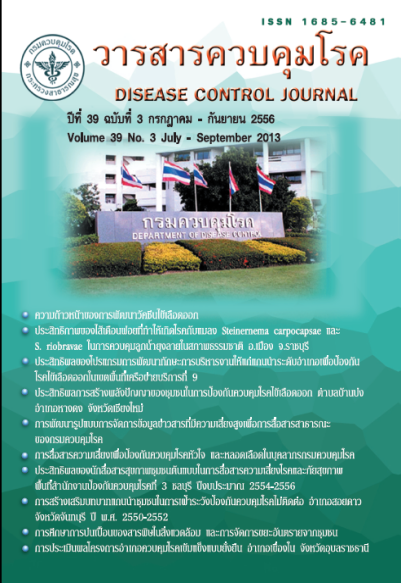A study of environmental contamination from hazardous waste and the community management
DOI:
https://doi.org/10.14456/dcj.2013.18Keywords:
Hazardous Chemical Waste, Health Impacts, Hazardous Waste ManagementAbstract
The purpose of this cross-sectional survey was to measure the levels of chemicals contaminated from hazardous waste and to describe the waste management activities in communities. The target sites were 12 communities in 12 Provinces where wastes were produced more than 50 tons per day. The methods of the study consisted of 2 steps. The first one was to measure chemical contamination. 249 samples of soil from just below the surface of the soil and 235 samples of water from the surface of the soil were taken from anarea of 5 kilometres radius to search for toxic chemicals and heavy metals. There were 2 kinds of methods of analysis. One was the method of analysing the soil: Test Method of Evaluating Solid Waste, Physical/ Chemical Methods (SW-846) of USEPA. The other was the method of analysing the water: inductively coupled plasma-optical emission spectrometer (ICP-OES) and graphic furnace atomic absorption spectrometer (GFAAS). The results were obtained by descriptive analysis such as number, percentage and median, data presented by having group conversation. The second step was to perform to obtain information from 35 people including local administration group, sorting waste labors, used good collectors and village representatives. The results of this study pointed out the level of arsenic, cadmium and zinc from soil level B in thesurrounding areas of landfills in Chiangmai province exceeded the recommended limit with median 34.0, 1.1 and 90.0 mg/kg, respectively. The level of cobalt in the surrounding areas of landfills in Lampang, Udontani, Kalasin, Nakhonsawan, Kanchanaburi, Prachuabkirikan and Phuket province were found to exceed the recommended limit with median 30.0, 26.0, 28.0, 28.0, 24.0, 50.0 and 22.0 mg/kg respectively. Also the levels of zinc were higher than the recommended limit in Udon thani ,Nakhon sawan, Chachoengsao, Uratthani province with median 1.17, 1.21, 2.81, and 1.33 mg/l, respectively. The results of the communities management showed that 12 provinces had no good management model on sorting out hazardous wastedisposal. 41.7% of respondents had no knowledge of how to get rid of sorted hazardous waste. 58.3% of respondents revealed that they had never separated hazardous waste before dumping or mashing or burying.The lack of staff and knowledge was also a limitation of this waste management system. According to theresult of this study showed that all involved agencies should have some support. Moreover, special managementis required for local authority agencies in order to set up an effectively hazardous management system.This will be useful in decreasing contamination of surface water and soil by hazardous chemical waste.
Downloads
References
2. Berry M, Bave F. Birth weight reduction associated with residence near a hazardous waste landfill. Eviron Health Perspect 1997; 105: 856-61.
3. กรมส่งเสริมคุณภาพสิ่งแวดล้อม. การจัดการของเสียอันตรายในประเทศไทย [ออนไลน์]. [สืบค้นเมื่อวันที่ 10 กันยายน 2553]; แหล่งข้อมูล:
URL:www.environnet.in.th.
4. Huo X, Peng L, Xu X, Zheng L, Qiu B, Qi Z, et al. Elevated blood lead levels of children in Guiyu,an electronic waste recycling town in China.
Eviron Health Perspect 2007; 115(7): 1113-7.
5. Kasassi A, Rakimbei P, Karagiannidis A, et al. Soil contamination by heavy metals: Measurements from a closed unlined landfill. Bioresource Technology.2008; 99(18): 8578-84.
6. โอเคเนชั่น. ข้อเสนอสมัชชาสุขภาพแห่งชาติครั้งที่ 2 การจัดการขยะอันตรายจากชุมชน [ออนไลน์]. [สืบค้นเมื่อวันที่ 14 พ.ย. 2554]; แหล่งข้อมูล: URL:
www.oknation.net/blog/print.
7. ไทยรัฐออนไลน์. สารพิษบ่อขยะสระบุรี [ออนไลน์].[สืบค้นเมื่อวันที่ 26 พ.ย. 2553]; แหล่งข้อมูล :URL:www.thairath.co.th/edu/49263.
8. ชัชพล โพธิสุวรรณ. ปัจจัยที่มีอิทธิพลต่อพฤติกรรมการจัดการของเสียอันตรายจากบ้านเรือน: กรณีศึกษาประชาชนที่มีบ้านพักอาศัยอยู่ตำบลสุเทพ อำเภอเมือง จังหวัดเชียงใหม่ (วิทยานิพนธ์ศิลปศาสตร์มหาบันทิต). สาขาวิชาการจัดการมนุษย์กับสิ่งแวดล้อม. บัณทิตวิทยาลัย: มหาวิทยาลัยเชียงใหม่; 2542.
9. สมบูรณ์ อำพนพนารัตน์ และคณะ. แนวทางการพัฒนาระบบการจัดการขยะแบบมีส่วนร่วม: กรณีศึกษาเทศบาลตำบลบ้านกลาง จังหวัดลำพูน.[ออนไลน์]. [สืบค้นเมื่อวันที่ 24 พ.ย. 2554]; แหล่งข้อมูล: http://www.deqp.go.th/website/20/index.php?option=com_content&view =article&id=4612&lang=th.
10. United states Environmental Protection Agency (USEPA). Test methods for evaluating solid waste, physical/chemical methods (SW-846) [online]. 2008 January 3 [cited 2011 Dec 20]; Available from:URL:http://www.epa.gov/ epawaste/hazard/ testmethods/sw846/index.htm.
11. American Public Health Association (APHA). Standard methods for the examination of water and wastewater [online]. 1999 [cited 2011 Dec 20]; Available from: URL: http://w w w . m w a . c o . t h / e w t a d m i n / e w t /
mwa_internet_eng/ewt_dl_link.php?nid=223.
12. Aday LN. Designing conductiong health surveys. a comprehensive guide. 2nd ed. San Francisco, CA: Jossey-Bars Publishers; 1996.
13. Shusterman D, Lipscomb J, Neutra R, Satin K. Symptom prevalence and odor-worry interaction near hazardous waste sites. Eviron Health Perspect 1991; 94: 25-30.
14. Karnchanawong S, Limpiteeprakan P. Evaluationof heavy metal leaching from spent household batteries disposed in municipal solid waste.Pub Med 2009; 29(2): 550-8.
15. Baumann T, Fruhstorfer P, Klein T & Niessner R. Colloid and heavy metal transport at landfill sites in direct contact with groundwater. Water Research 2006; 40(14): 2776-86.
16. ชนิดา เพชรทองคำ และคณะ. การบริหารจัดการขยะ และเทคโนโลยีที่เหมาะสมโดยการมีส่วนร่วมของชุมชน: กรณีศึกษา อบต.ไร่ส้ม จ.เพชรบุรี.[ออนไลน์]. [สืบค้นเมื่อวันที่ 24 พ.ย. 2554];แหล่งข้อมูล : http://203.157.181.2/f_cuppt/attach/4485/%E0%....%B8%B0.pdf.
Downloads
Published
How to Cite
Issue
Section
License
Articles published in the Disease Control Journal are considered as academic work, research or analysis of the personal opinion of the authors, not the opinion of the Thailand Department of Disease Control or editorial team. The authors must be responsible for their articles.


.png)



